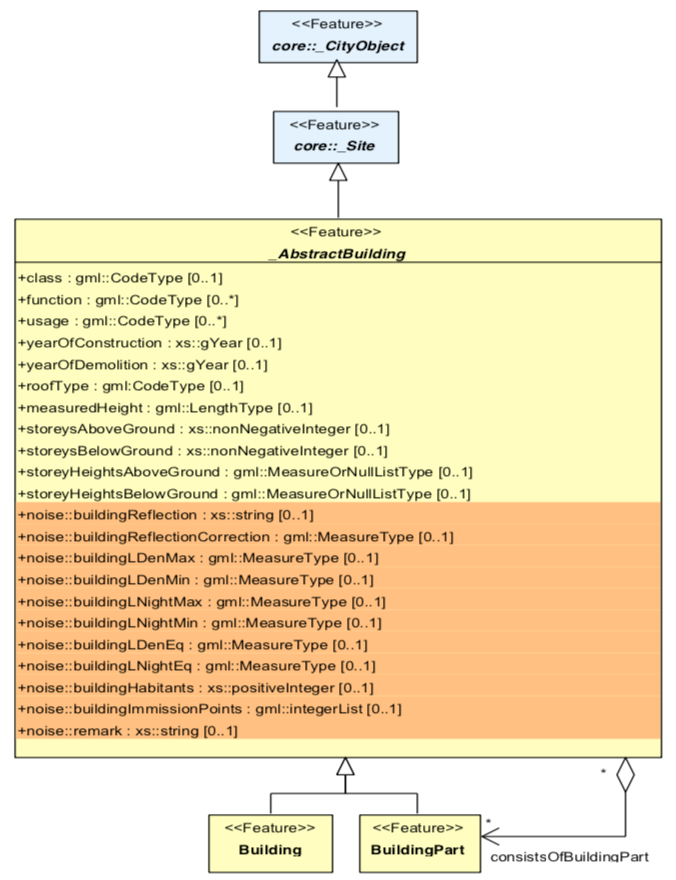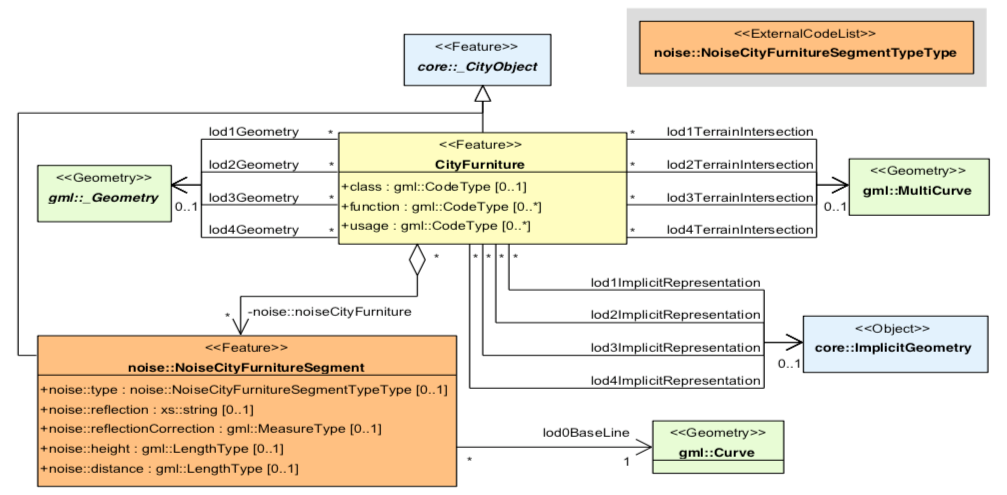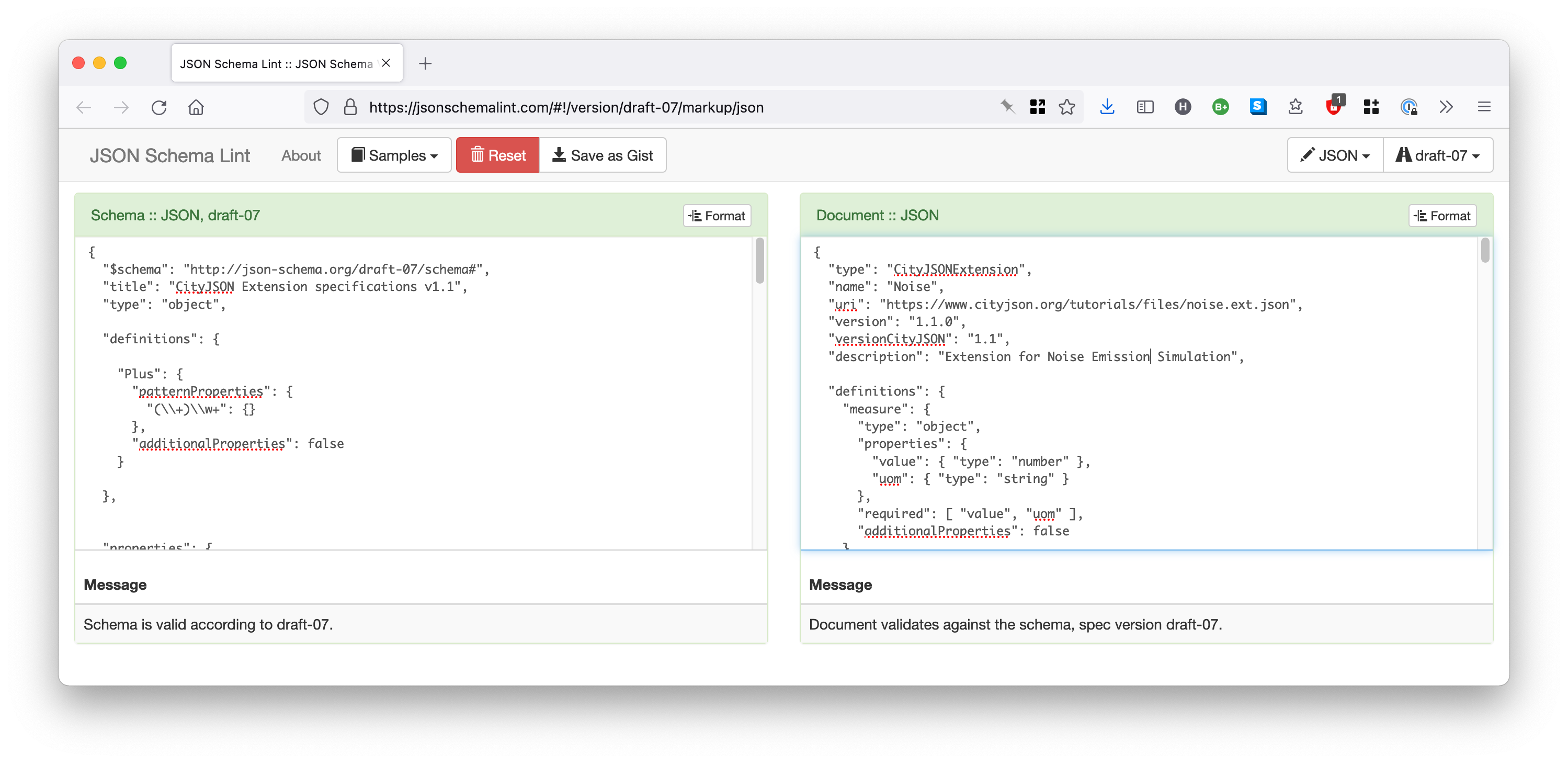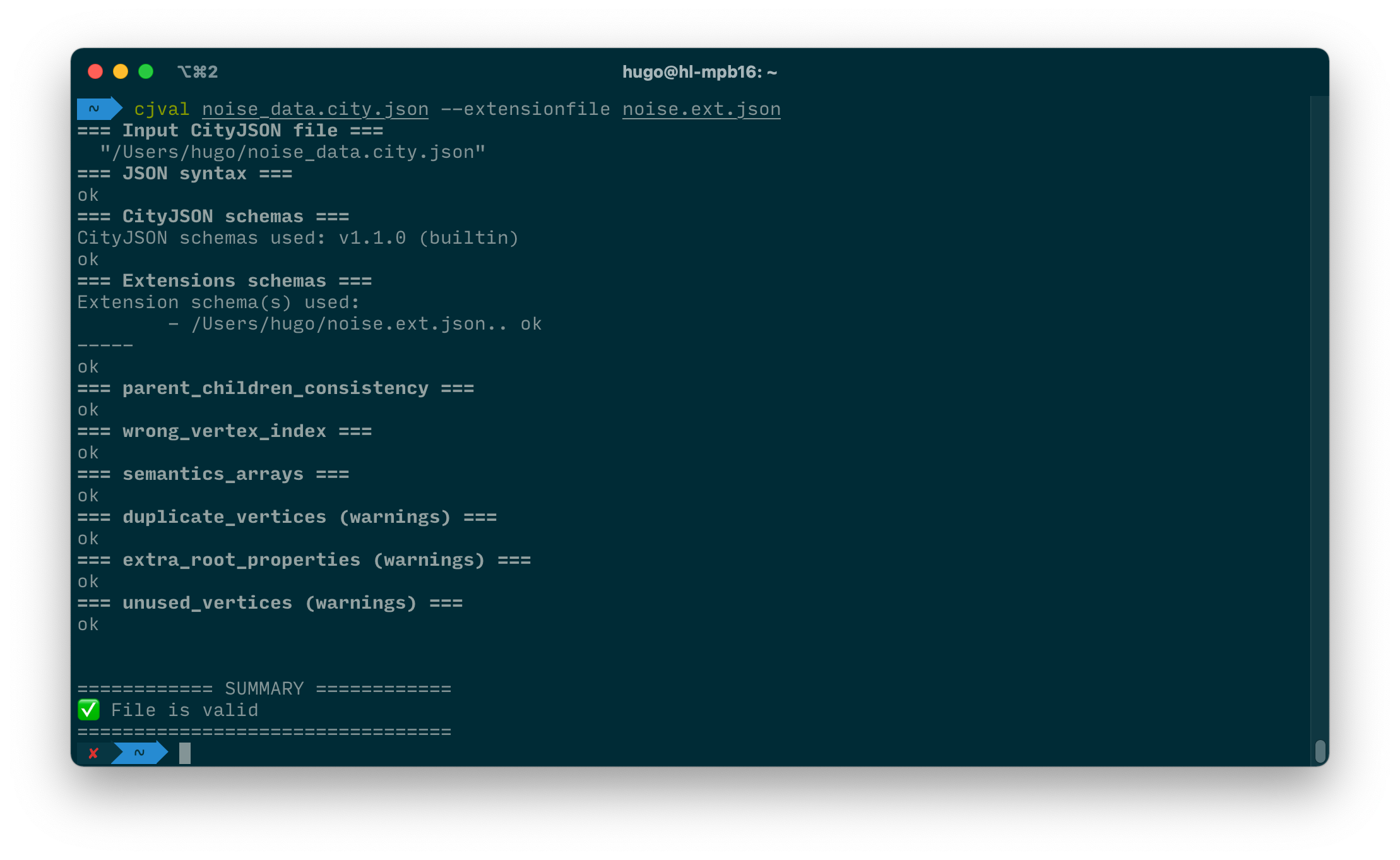Mapping the Noise ADE to a CityJSON Extension
This is the manual for CityGML v2.0 ADEs because v3.0 is not really having many examples. This will be updated at some point.
Table of contents
- Adding new attributes to Buildings
- Adding complex types for CityFurniture
- Validation of the CityJSONExtension file
To illustrate the process of creating a new CityJSON Extension, we use the Noise ADE, which is the example case in the CityGML 2.0 documentation (Section 10.13.2 on p. 151 describes it; and Annex H on p. 305 gives more implementation details). The XSDs and some test datasets are available here.
The resulting files for this tutorial are available:
Adding new attributes to Buildings

We first need to define the new attributes and specify that they can be used for "Building" and "BuildingPart"
"definitions": {
"measure": {
"type": "object",
"properties": {
"value": { "type": "number" },
"uom": { "type": "string" }
},
"required": [ "value", "uom" ],
"additionalProperties": false
}
},
"extraAttributes": {
"Building": {
"+noise-buildingReflection": { "type": "string" },
"+noise-buildingReflectionCorrection": { "$ref": "#/definitions/measure" },
"+noise-buildingLDenMax": { "$ref": "#/definitions/measure" },
"+noise-buildingLDenMin": { "$ref": "#/definitions/measure" },
"+noise-buildingLDenEq": { "$ref": "#/definitions/measure" },
"+noise-buildingLNightMax": { "$ref": "#/definitions/measure" },
"+noise-buildingLNightMin": { "$ref": "#/definitions/measure" },
"+noise-buildingLNightEq": { "$ref": "#/definitions/measure" },
"+noise-buildingHabitants": { "type": "integer" },
"+noise-buildingAppartments": { "type": "integer" },
"+noise-buildingImmissionPoints": {
"type": "array",
"items": { "type": "integer" } },
"+noise-remark": { "type": "string" }
},
"BuildingPart": {...}
}
A CityJSON file containing this new City Object would look like this:
{
"type": "CityJSON",
"version": "1.1",
"extensions": {
"Noise": {
"url" : "https://www.cityjson.org/tutorials/files/noise.ext.json",
"version": "1.1"
}
},
"CityObjects": {
"1234": {
"type": "Building",
"attributes": {
"roofType": "gable",
"+noise-buildingReflectionCorrection": {
"value": 4.123,
"uom": "dB"
},
"+noise-buildingLNightMax": {
"value": 43.123,
"uom": "dB"
}
},
"geometry": [...]
}
}
}
Adding complex types for CityFurniture

As it can be seen in the UML diagram, extending "CityFurniture" is more challenging because not only new simple attributes need to be defined, but a "NoiseCityFurnitureSegment" object, which has its own geometry (a ‘gml:Curve’).
The steps to follow are thus:
- Create new City Object:
"+NoiseCityFurnitureSegment" - Since
"CityFurniture"is allowed to have"children"(all City Objects), we can reuse this to link a given"CityFurniture"to its children"+NoiseCityFurnitureSegment". "+NoiseCityFurnitureSegment"is a new City Object and it gets the attributes common to all City Objects, and its geometry is restricted to a"MultiLineString". It also gets one property"parent"which links to its parent"CityFurniture".
"+NoiseCityFurnitureSegment": {
"allOf": [
{ "$ref": "cityobjects.schema.json#/_AbstractCityObject"},
{
"properties": {
"type": { "enum": ["+NoiseCityFurnitureSegment"] },
"attributes": {
"properties": {
"reflection": { "type": "string" },
"reflectionCorrection": { "$ref": "#/definitions/measure" },
"height": { "$ref": "#/definitions/measure" },
"distance": { "$ref": "#/definitions/measure" }
}
},
"parent": {
"type": "string",
"description": "the ID of the children CityFurniture"
},
"geometry": {
"type": "array",
"items": {
"oneOf": [
{"$ref": "geomprimitives.schema.json#/MultiLineString"}
]
}
}
},
"required": ["type", "parent", "geometry"]
}
]
}
"a_noisy_bench": {
"type": "CityFurniture",
"geometry": [
{
"type": "Solid",
"lod": "2",
"boundaries": [
[ [[0, 3, 2, 1]], [[4, 5, 6, 7]], [[0, 1, 5, 4]], [[1, 2, 6, 5]], [[2, 3, 7, 6]], [[3, 0, 4, 7]] ]
]
}
],
"children": ["thesegment_1", "thesegment_2"]
},
"thesegment_1": {
"type": "+NoiseCityFurnitureSegment",
"geometry": [
{
"type": "MultiLineString",
"lod": "0",
"boundaries": [
[2, 3, 5], [77, 55, 212]
]
}
],
"parent": "a_noisy_bench",
"attributes": {
"reflectionCorrection": 2.33
}
}
Validation of the CityJSONExtension file
First use this simple JSON schema to ensure that your CityJSONExtension is syntactically valid. You can use an online JSON Schema validator:

To validate a given CityJSON file, you can use the online validator: just drag the file noise_data.city.json, the validator will fetch the Extension schema automatically and validate the file (it should return valid here).
If you want to test things locally while developing your own Extension, you can do the same with the file locally. First, install cjval (the README explains how). If you use the option --extensionfile when validating, the Extension schemas will not be fetched automatically.
